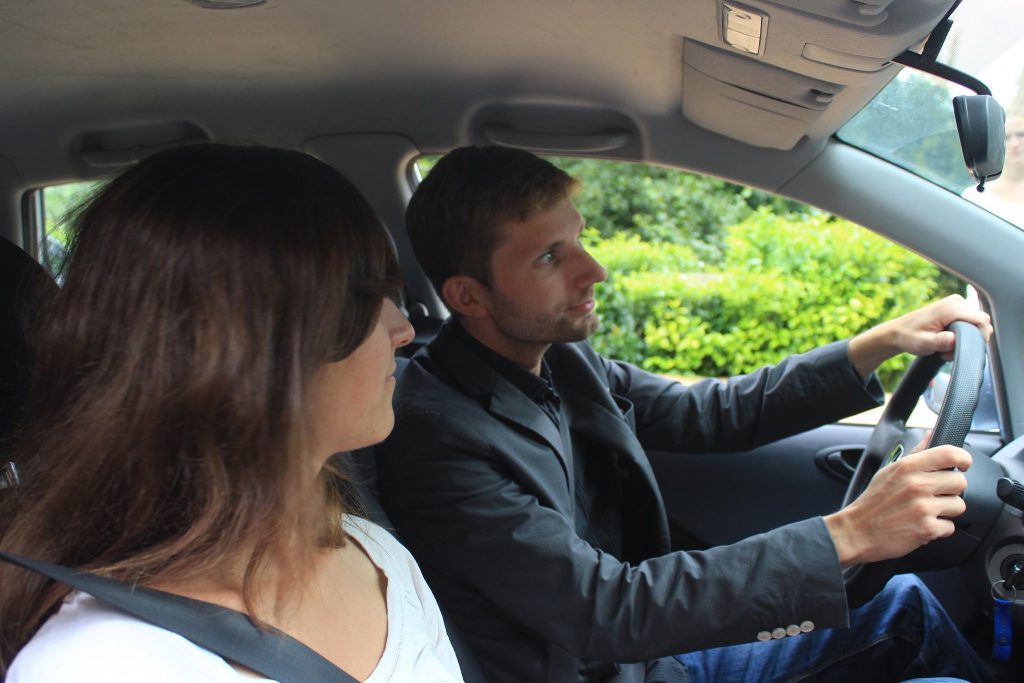InTrans / Apr 27, 2017
Green infrastructure: One ‘step’ at a time
Go! Magazine
 posted on April 27, 2017
posted on April 27, 2017
The PlasticRoad and 3D printed bridges may be the future of green infrastructure, but what can we do today to lessen our carbon footprint? Ironically, it does have to do with feet.
Green infrastructure can’t do it alone, because the biggest instigator is what uses the infrastructure—us, and well, the cars we drive.
During the past century, dependence on vehicles burning petroleum-based fuels has become a defining component of American life. The United States, with less than five percent of the world’s population, is home to more than one-fifth of the world’s automobiles.
You could go electric, or even hybrid, when purchasing your next car, but if that’s not in the cards, what can you do now?
Consider your commute
First and foremost, consider your commute: How do you get to work or school every day? If you have to drive, what about carpooling?

Photo from Flickr user Traject Mobility.
Giving your car a rest a few times a week can help reduce carbon emissions, not to mention it can save you money. The average price of gas in the United States is about $2.40/gallon to date, and the average commute to work is about 25 minutes (or 15 miles).
Although cars have a variety of mpg (miles per gallon) capabilities, the cars that came out in 2016 had mpg ratings from 12 to 37, or about 24.5 mpg on average. That means that every gallon of gas can get the average car a distance of 24.5 miles.
So on average, it costs Americans about $15 to get to work every week, or about $765 a year in fuel costs. By sharing a ride with a friend, say, twice a week, the average American could save something like $6 a week and about $300 a year on fuel!
One company turned carpooling into a science! Uber, a mobile app that connects passengers to a driver—like using an app to hail a taxi cab—now offers a rideshare option called uberPOOL, where users can “share a ride” while saving money on their fare too.
Take a bike!
Another way to give your car a break is to take a bike! Some cities even have bike sharing programs like the Divvy bike share program in Chicago, Illinois.

Photo from Flickr user Res Ipsa Loquitur.
With 580 Divvy bike stations and 5,800 Divvy bikes across the city, Divvy bikes are finding their place in the lives of many Chicago locals and tourists. The best part? Divvy bikes are benefiting the environment by replacing fossil-fueled transportation.
The company claims their bikes are a fun, affordable, and convenient way to get around—not to mention Divvy bike riders are unrestrained from commuter restrictions like blocked roads, construction work, red lights, and traffic jams. A Divvy bike pass costs $9.95 for the day or $99 for an annual pass.
With the average median salary for workers at about $44,000 in 2016, Divvy bikes give city commuters the option to spend their monthly or yearly transportation allowance on bike-based instead of car-based transportation, which is much cheaper than the alternative. As it is, the average American household spends about $250 a month, or 14 percent of their budget, on transportation.
“Walkable” cities
Cities are one of the most accessible places to “go green” with your commute.
With more people, shops, and centers within a smaller, more condensed area, walking becomes a very-real option when commuting. Although it’s easier said than done, as some cities are more “walkable” than others!
The most walkable city in the United States—rated based on population and amenities within certain walking distances—is New York! Other top walkable cities include Jersey City, San Francisco, Boston, Newark, Philadelphia, Miami, Chicago, Washington DC, and Seattle.
Research suggests walkable cities have higher rates of physical activity, less obesity, and less air pollution from traffic.
How will you “go green?”
Remember, promoting green practices is entirely up to you. But if you do decide to adjust your schedule and carpool or invest in riding a bike or walking to your destination, every effort does count. Green initiatives, especially ones that involve your own two feet, are a great investment in both the environment and your own health.
What are you waiting for? Is it time to clean up your transportation routine?
References
www.needtoknow.nas.edu/energy/energy-use/transportation/
www.epa.gov/air-pollution-transportation/accomplishments-and-success-air-pollution-transportation
www.thebalance.com/average-salary-information-for-us-workers-2060808
www.valuepenguin.com/average-household-budget
Related links
(Video) Riding Divvy bikes in Chicago: https://www.youtube.com/watch?v=SqWt0e0j6LE
(Video) Biking to work like a pro commuter: https://www.youtube.com/watch?v=0kp3ILTPwbM
(Video) 10 tips for commuting by bike: https://www.youtube.com/watch?v=deuWgGzNCK8
(Video) TED Talks, The walkable city: https://www.youtube.com/watch?v=Wai4ub90stQ
Living in a walkable city: http://www.voanews.com/a/living-in-a-walkable-city/3109373.html
By Hannah Postlethwait, Go! Staff Writer